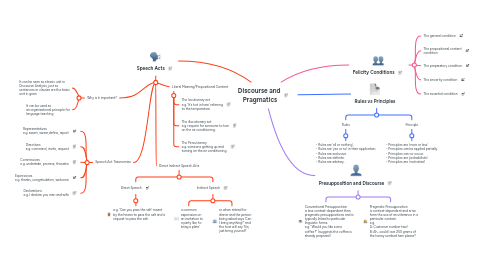
1. Speech Acts
1.1. Why is it important?
1.1.1. It can be seen as a basic unit in Discourse Analysis, just as sentences or clauses are the basic unit in gram
1.1.2. It can be used as an organisational principle for language teaching
1.2. Literal Meaning/Propositional Content
1.2.1. The locutionary act e.g. ‘It’s hot in here’ referring to the temperature.
1.2.2. The illocutionary act e.g. request for someone to turn on the air conditioning.
1.2.3. The Percutionary e.g. someone getting up and turning on the air conditioning.
1.3. Direct Indirect Speech Arts
1.3.1. Direct Speech
1.3.1.1. e.g. 'Can you pass the salt' meant by the hearer to pass the salt and a request to pass the salt.
1.3.2. Indirect Speech
1.3.2.1. a common expression on an invitation to a party like ‘to bring a plate’
1.3.2.2. or when attend for dinner and the person being asked says ‘Can I bring anything?’ and the host will say ‘No, just bring yourself’
1.4. Speech Act Taxonomies
1.4.1. Representatives e.g. assert, swear,define, report
1.4.2. Directives e.g. command, invite, request
1.4.3. Commissives e.g. undertake, promise, threaten
1.4.4. Expressives e.g. thanks, congratulation, welcome
1.4.5. Declarations e.g. I declare you man and wife
2. Rules vs Principles
2.1. Rules
2.1.1. ~ Rules are 'all or nothing'. ~ Rules are 'yes or no' in their application. ~ Rules are exclusive. ~ Rules are definite. ~ Rules are arbitary.
2.2. Principle
2.2.1. ~ Principles are 'more or less' ~ Principles can be applied partially. ~ Principles can co-occur. ~ Principles are 'probabilistic' ~ Principles are 'motivated'
